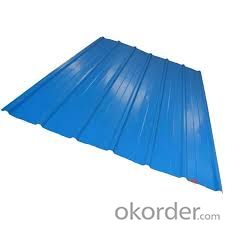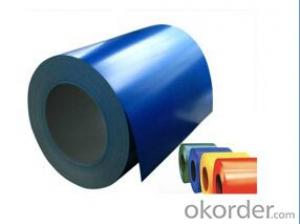Prepainted Steel Coil/Prepainted Rolled Galvanized Steel Sheet Coil/PPGI
- Loading Port:
- China main port
- Payment Terms:
- TT OR LC
- Min Order Qty:
- 25 m.t.
- Supply Capability:
- 1000 m.t./month
OKorder Service Pledge
OKorder Financial Service
You Might Also Like
Pre-painted Steel Coil
Product Description
Product Description
| PRODUCT SPECIFICATION |
Commodity | Prepainted galvanized steel coil |
Base Metal |
|
| 0.16 TO 1.00 mm |
Width | 600 TO 1500 mm |
Coil ID | 508 / 610 mm |
Type | coil/sheet/strips |
|
|
| Soft, medium,full hard |
Zinc Coating | Z 40-275 gsm, AZ 40-180 gsm or as customer requirements |
Types of top coating |
|
| As per RAL shades/customer requirements. |
Surface Finishes | Glossy and Matte |
Price: | US $600-800 / Metric Ton |
Slits | 37mm and above |
Standards | AISI, ASTM, BS, DIN, GB, JIS |
Transport | By bulk or container |
Packing | Standard packing or at buyer's requirement |
Applications:
Pre-painted steel metal products are used in a vast array of applications including:
1.construction industry
2. household appliances
3.automotive
4.industrial applications
5.packaging



FAQ
What is the validity of your quotation?
Normally 2 days.
- Q: How are steel coils used in the production of steel fasteners?
- Steel coils are used in the production of steel fasteners as they serve as the raw material for manufacturing various types of fasteners such as screws, bolts, nuts, and washers. The steel coils are unwound and then processed through machinery that cuts, shapes, and forms them into the desired fastener shape. This allows for efficient and precise production of steel fasteners, ensuring their strength, durability, and compatibility with various applications.
- Q: How are steel coils used in the packaging industry?
- Steel coils are used in the packaging industry to create sturdy and durable packaging materials, such as metal drums, cans, and containers. The coils are unwound and shaped into the desired form, providing a strong and protective barrier for various products during storage and transportation.
- Q: Can cold rolled galvanized steel coils be acid washed after oxidation?
- If it has been galvanized, it can not be pickled, and if it is pickled, it may corrode the zinc layer
- Q: All of my friends say that if a car made of mostly carbon fiber would crash into a full steel car, or vice versa, the steel car would be DESTROYED and the carbon fiber would drive away, if not, easily repairable.
- At a reasonably high speed, both cars would be undrivable. That's by design, not due to the strength/weakness of the materials. The energy in an impact needs to go somewhere. Cars are designed so the body and the frame will bend and break, reducing the impact on the occupants. If the car is too rigid the chances of the occupants being injured increases. Carbon fiber composites do have a better strength to weight ratio than steel but they're also a lot less dense, so the same volume of material will have a similar strength. The primary benefit to carbon fiber is that for a part of the same strength the carbon fiber part will weigh less than the steel part.
- Q: Can steel coils be coated with chrome?
- Yes, steel coils can be coated with chrome.
- Q: How much do steel coils weigh?
- The weight of steel coils can vary depending on their size and thickness, but on average, they can weigh anywhere from a few hundred pounds to several tons.
- Q: How are steel coils inspected for defects after recoiling?
- Steel coils are inspected for defects after recoiling through a thorough visual examination and non-destructive testing techniques such as ultrasonic or magnetic particle inspections. These methods identify any surface imperfections, cracks, or abnormalities in the steel coils to ensure their quality and integrity.
- Q: I have two guitars, a nylon stringed classical, and a steel stringed acoustic, I find the nylon strings easier to play, but doesn't have as good of sound as the steel stringed, and when I play with the steel strings, it really hurts my fingers, and if I play just a little bit, it feels like the high e string is going to cut my finger. Are the strings too high? What can I do to make the steel strings easier to play?
- If you want to end up playing acoustic steel string, continue learning on that one. Yes, it will hurt, but that's normal and your fingers will toughen up within a couple of weeks of playing (if you play on a regular basis). You will develop callouses. Also, go take your guitar to a shop to get a set up and they will fix the action if it's too high. (Too high action makes the guitar harder to play). When I started playing, at first my fingers *HURT*, but now they don't anymore, even the pinky. :D
- Q: How do steel coils differ in terms of size and weight?
- The size and weight of steel coils can vary greatly depending on their intended use and production process. When it comes to size, a steel coil is typically measured by its outer diameter, inner diameter, and width. The outer diameter refers to the total diameter of the coil, while the inner diameter refers to the diameter of the hollow center. The width, on the other hand, is the distance between the two flat sides. In terms of weight, steel coils can range from a few hundred pounds to several tons. The weight primarily depends on the size and type of steel used. Coils made from high-strength steel are generally heavier because they have a higher density. On the contrary, coils made from lower-grade steel can be lighter. The size and weight of steel coils play a crucial role in their transportability and handling. Smaller and lighter coils are easier to handle and transport, making them suitable for applications that require maneuverability. On the flip side, larger and heavier coils are commonly used in industries that prioritize strength and durability, like construction and automotive manufacturing. All in all, steel coils come in various sizes and weights, allowing for customization and meeting specific requirements in different industries.
- Q: How did the growth of the steel industry influence the development of other industries?
- At least three ways: 1. Steel as a material that other industries could use to do things that couldn't be done before (for example, construction (skyscrapers, long bridges, etc.)) or could now be done at much lower cost and hence increased the size of the industry (automobiles, bearings, etc.)
Send your message to us
Prepainted Steel Coil/Prepainted Rolled Galvanized Steel Sheet Coil/PPGI
- Loading Port:
- China main port
- Payment Terms:
- TT OR LC
- Min Order Qty:
- 25 m.t.
- Supply Capability:
- 1000 m.t./month
OKorder Service Pledge
OKorder Financial Service
Similar products
Hot products
Hot Searches
Related keywords




























